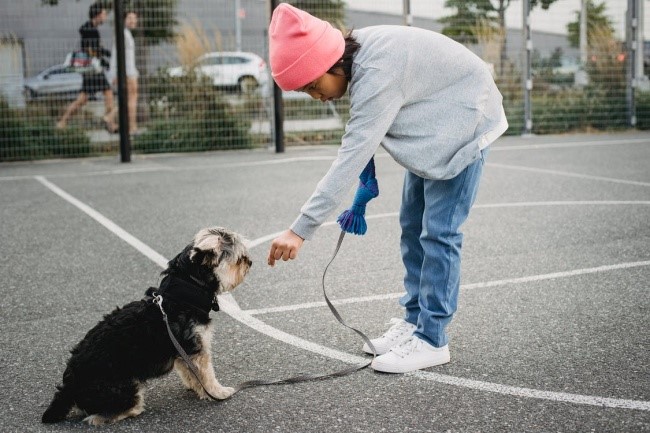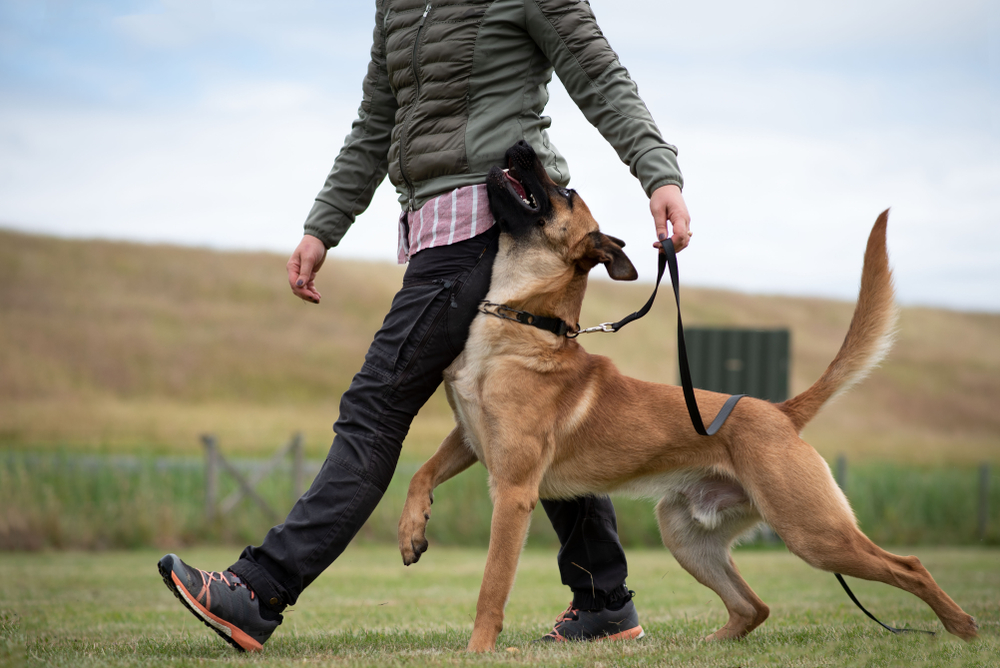Teach Dogs How to Heel: How to Train a Dog to Walk Beside You
Dogs are the best company when you’re out walking. Taking your dog along is great for company and offers them a good opportunity to get some exercise.
Once outside, however, dogs tend to wander around, making pet parents anxious. But there are several solutions to manage this bad pet behavior, one of which is to teach a dog to heel.
Teaching a dog how to heel may feel hard for the unversed. Such misconception deters you from starting the training. But did you know that you can teach dogs to heel even without professional help?
That’s what we will talk about in this article in the hopes that you will be able to train your dog so that he can walk beside you without problems.
What Is Heeling?
Heeling is one way to help control your dog during your daily walk. Technically, the meaning of “heel” is when a dog walks next to you (or whoever he is walking with).
The dog can be either on your left or right side, depending on which is more comfortable. The dog should be close to your leg and not walking in front of you or behind you.
When a dog is at the heel, its head and neck should be aligned with your leg. The position of the dog’s neck and head varies depending on its role.
For dogs in obedience competitions, dogs look up to their dog trainer. Meanwhile, service and working gun dogs look ahead.

Benefits of Heeling
There are several advantages to be had as you teach dogs to heel. Some of the advantages of heel training are the following:
No Leash Pulling
Some dogs think they control their owners, and rightfully so. As much as we love our canines, we let them drag us here and there during walks. We need to learn how to control them.
Big dogs that take the lead and pull their owners are hard to control. Dog owners often find themselves being dragged even if they do not want to.
The benefit of heel training is to give owners a chance to control the dogs – no matter how big or small they are – while walking. This will help manage the dogs better, especially in crowded and unsafe areas.
You can also try loose leash walking as well if you find yourself having to constantly pull on their leash during a walk.
During a loose leash walk, your dog is walking by your side while not pulling on the leash and can make training your dog on walks much more enjoyable.
Serves as a Mental Exercise for Dogs
Heel training serves as a mental exercise for dogs. It stimulates their mind while keeping a structured walking routine. The dog in heel position sees you on his peripheral vision.
Such position placement reminds your dog that you are calling the shots. Moreover, the heel position provides dogs a way to focus more on the person they are walking with instead of the environment.
That being said, 75% of your canine’s mental focus is on keeping its heel position. Therefore, only 25% is left for possible distractions.
Bonding Time
The more you spend time with your dog during training, the more you can bond with him. Canines love to be with their pet parents most of the time.
So, if you undertake the role of being your dog’s personal trainer for heel lessons, then it’ll be a worthy bonding moment between the two of you. However, make sure that you use positive training methods to nurture your bond with your canine even more.
How to Prepare Heel Training Sessions
There are only three things that you need to consider when you want to teach dogs to heel:
Choose the Treats
Training your dog with a treat is a must. Treats serve as a bribe for dogs to listen to your commands. The start of training requires many treats, especially when you have to introduce a new command.
For this reason, you need to look for treats that won’t ruin your dog’s diet. It is also helpful to get something that your dog cannot resist. When choosing a treat for training, small pieces work the best.
Another thing to consider when picking a treat to be used during heel training is your dog size. Small dogs may find it hard to bend down when in the heel position.
You need to improvise your tactic. One favorite technique of canine owners who personally train their dogs is to cover a long spoon with peanut butter or their dog’s wet food.
Pick a Training Location
A training location needs to be safe and away from any distractions. You can train your dog inside your yard if you have a fence to protect him from wandering around.
Distractions such as cars passing can tempt your dog to lose focus on the training. Be sure that you pick a location that is generally safe and has no distractions but also with enough space for you to do your training.
Schedule the Training
Training requires a regular schedule. The best way to teach dogs to heel entails training sessions two to three times a day for five to ten minutes. You need to schedule your own daily routine as well, especially if you have work to attend to.
Having regular daily sessions with your pup will increase its chances of getting acquainted with the heel command in no time. Though you can train your dog during the weekends or twice or thrice a week, the improvement will be slow.

Teach Dogs to Heel: A Step-by-Step Guide
Once you get the preparation sorted out, you may begin the training with treats in hand inside a safe location.
Step 1
Position your dog. Most trainers would teach dogs to heel starting from a sitting position on their left side. But the side depends on where you are comfortable. You may choose to position your dog on your right side if it works best for you.
As soon as the dog is in position, you can say “yes” or use a clicker.
Step 2
Show the treat in your hand to your dog, and let it sniff the treat. The treat will act as bait so that your dog will follow you. You need something that the dog cannot resist. If treats don’t work, you may use a toy.
Hold your hand against the side of your choosing so that the dog will know which side to follow. Say your dog’s name and “heel,” then slowly walk a few steps. Your pup may not know what to do just yet. Encourage him to follow the treat that you have in your hand.
As soon as the dog comes beside you, click the “clicker” or positively reinforce him with a treat to affirm that what he did was right.
Repeat the same procedure a few times while continuously rewarding your dog every time he gets it right and show more positive reinforcement. You can gradually increase your steps to cover more distance as you deem fit for every session.
Step 3
From this point onward, your dog should know how to comply with your “heel” command. You can tap your hand to the side to give him the signal to follow you.
Additionally, you can advance the training by adding more challenges for the pooch to solve, such as walking in a zigzag pattern or turning.
Try losing your dog’s direction so that he’ll know how to find his heel position again. Do not forget to reward your dog every time he finds the correct position.
Whenever a dog loses its direction or walks ahead of you, tap your side to signal to him to come back. You can also use a verbal command as well.
Step 4
When you teach dogs to heel, you should know when to start handing out fewer treats. After a few sessions of training, the dog can walk for several yards now without any problems.
As soon as this happens, you can reduce the treats you are giving them during these training sessions. However, keep up with the good verbal praise and pats to assure your dog that he’s doing it well.
If you are accustomed to giving the treat to your dog every ten steps or so, adjust it to 15. But be sure to adjust the time you give the treat to align with your dog’s attention span. Make sure to give the treat to your dog before he becomes inattentive and gets distracted by other things.
Step 5
As soon as you can walk for several yards in a safe environment with fewer treats, you may now add more distance to the walk. You can still give your dog treats occasionally, but do not overdo it.
Step 5 is an essential part to remember when teaching a dog how to heel. Since you are adding more and more distance at this phase, you can frequently find your pooch breaking out from his heel position.
It may mean that you are progressing too quickly for your dog to follow. Do not lose your patience. Instead, go back to the number of steps and treats you were doing when your dog was still effectively following you.
Step 6
As soon as your dog has perfected the heel command already, try the challenge of bringing him outside. You can bring your dog to a park or within your neighborhood.
These walks may require your dog to be on a leash, considering that you do not know how well he would respond to the command when external distractions are present. It is better to keep your dog safe than regret it in the end.
Bring a lot of treats when you go outside. Since this is a new environment, expect your dog to wander around. Dogs can get easily distracted by external stimuli. You have to get the dog’s attention by giving treats and highlight positive reinforcement again.
Just walk for a fairly short distance for a while, and only increase the distance as soon as the dog understands that he needs to do what he was trained for back then. Reduce the number of treats you give just like you did on Step 4.
Step 7
Covering a vast distance outside can be a challenge at first when you teach dogs to heel. But once you have covered a fairly long distance with your dog, oblivious to all distractions, you can start phasing out treats. Do this gradually by adding more distance to the walk but limiting the treats you give.
Observe your dog’s body language. Most often, owners know their dogs well enough to foresee what they will do next even before they do it. You can prevent the dog from breaking away from his heel position.
A dog’s body language often shows when something catches his attention and causes a distraction. When you notice this happening, give him the heel command and walk in the opposite direction of the distraction. At the end of the heel training, your dog should be able to walk a long distance with no to fewer treats given.
Takeaway
Every dog training session requires patience and consistency from the dog owner and the dog. So, you have to embody both if you want your canine to learn from you.
Heel training is very useful to have, especially when your dog loves the outdoors. It provides him the freedom he needs and gives him more control of himself, not wander around when you call him to come to you.
Dogs have different learning times, just like humans do. When you teach dogs to heel, they process it differently as well. Some dogs are fast learners, while some are not. If it comes to the point that a dog forgets what he is training for, do not lose your cool.
Instead, refresh his memory by going back a step or two. This training is not about how well you train your dog, but rather how ready your pup is to accommodate all the things you want him to remember and do.
Learning the heel command makes every walk and run a memorable one. No more leash pulling, and no more worrying about your dog roaming around. Now the challenge is on you: Are you ready to teach dogs to heel now?

